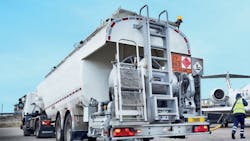Last September, the Biden administration announced a new plan to advance the future of sustainable fuels in the aviation industry and make progress toward the nation’s climate goals. The executive actions are intended to promote the production and use of billions of gallons of sustainable fuel that will result in a 20% reduction in aviation emissions by 2030 – with the ultimate goal of having fully zero-carbon aviation sector by 2050.
The plan also outlined steps to coordinate efforts across the federal government, aircraft manufacturers, commercial airlines, fuel producers, airports and non-governmental organizations to transform the aviation sector, boost the economy and tackle the climate crisis.
At the national level, the Federal Aviation Administration (FAA) and Environmental Protection Agency (EPA) are partnering to remove lead from aviation gasoline (avgas), which is the only remaining lead-containing transportation fuel in the U.S. The major challenge is to remove the use of leaded aviation fuels for piston engine aircraft without adversely impacting the existing general aviation fleet.
Currently, aviation represents approximately 11% of U.S. transportation-related emissions. Owners and operators of more than 190,000 piston engine aircraft operating in the U.S. rely on 100LL avgas to power their aircraft. Achieving a sustainable aviation industry requires improvements in both aircraft technology and operations. While electric and hydrogen-powered aviation have been identified as options for local and regional travel in the future, the deployment of alternative aviation fuels has been identified as the key to unlocking sustainable long-haul travel and is a critical first step.
However, the adoption of sustainable aviation fuels and phase-out of leaded avgas presents many challenges to the general aviation industry that require both innovation and leadership. First, no current unleaded fuels qualify as a drop-in replacement for 100LL avgas for 100% of the fleet, and the FAA requires type certification for engines and aircraft to use different fuels. Second, the limited quantity of unleaded fuel being produced is not widely available for airports. And, third, the entire aircraft fleet and engines do not satisfactorily operate with fuels less than 100 octane.
Considerable work must be done to address the environmental and regulatory challenges associated with piston aviation fuels, while protecting aviation safety and the economic health of airport sponsors, users and operators. Industry stakeholders and federal legislators must reach consensus on steps to phase out avgas in a manner that is well-organized and intentional, and recognize this must be accomplished at the national level.
In order to eliminate the one-by-one risks presented at airports where local interests seek to close airports for fuel-related emissions, this involves establishing federal legislation that incentivizes suppliers and presenting regulatory groups a feasible solution that first maintains the integrity of the national air transportation system.
For example, the Biden administration has proposed a sustainable aviation fuel tax credit to help cut costs and rapidly scale domestic production of sustainable fuels for aviation. The proposed tax credit requires at least a 50% reduction in lifecycle greenhouse gas emissions and offers an incentive for greater reductions. Other actions include a new federal challenge to increase production of sustainable aviation fuels to at least 3 billion gallons per year by 2030; up to $4.3 billion in new and ongoing funding to support fuel projects and fuel producers; and an increase in research and development activities for technologies that improve aircraft fuel efficiency by at least 30%.
However, to achieve a complete conversion to unleaded avgas in the U.S., critical supply chain issues must be addressed to ensure alternative sustainable aviation fuel is widely and reliably available. At the present time, there are very limited and undesirable alternatives available, such as the use of low-tech methanol or water additives and costly diesel engine conversions.
With the Biden administration planning to release an aviation climate action plan in the coming months, it is critically important that any future deployment of unleaded aviation gas be consistent with aviation safety. To this end, a collaboration of aviation industry organizations is working to increase federal funding for the FAA Alternative Fuels for General Aviation program in fiscal year 2022. Operated by the FAA William J. Hughes Technical Center, this program has established testing methodologies and requirements to support an efficient and safe fleet-wide authorization and deployment of alternative aviation fuel.
In a letter addressed to leaders of two Congressional committees last November, aviation groups asked to increase funding for the Alternative Fuels for General Aviation program from $4.96 million to $19 million, particularly in light of federal legislators’ focus on general aviation. The letter was signed by leaders of the Aircraft Owners and Pilots Association, General Aviation Manufacturers Association, National Air Transportation Association, Experimental Aircraft Association, Helicopter Association International and National Business Aviation Association.
Through its ongoing Piston Aviation Fuels Initiative (PAFI), the FAA, fuel suppliers and aerospace manufacturers continue to partner on developing high-octane, unleaded fuel formulations that provide operationally safe alternatives to 100LL avgas. Overall, the PAFI includes four key elements: 1) a fleet-wide authorization qualification test program, 2) new alternative fuel proposals and certification, 3) the establishment of FAA safety standards, and 4) executing an informed and safe transition of the general aviation fleet to an unleaded avgas once it is approved.
Development and prescreening testing is taking place at both private and public facilities across the country, with the FAA's William J. Hughes Technical Center providing engine testing services through Cooperative Research and Development Agreements (CRADA) with the individual fuel companies. The FAA also continues to support other fuel applicants who have decided to pursue engine and airframe approvals that would allow the use of their fuel formulations via traditional certification processes.
Identifying, testing and authorizing a fleet-wide unleaded avgas solution remains a difficult challenge, but one that the aviation industry is committed to meeting. While it might seem politically expedient to fast-track the process of testing and adopting a new environmentally friendly aviation fuel, it is unwise to place short-term gain above the long-term safety and economic health of the general aviation industry.
The commitment of aviation industry associations, aircraft and engine manufacturers, fuel producers and federal agencies to address concerns about lead emissions from piston aircraft remains clear. Regardless of the amount of time and effort it may take to achieve, there must be a smooth and safe transition to deploying a new high-octane, unleaded fuel that allows all general aviation aircraft to continue to fly safely and efficiently.
Curt Castagna, president and CEO of Aeroplex/Aerolease Group, is a member of the Los Angeles County Airport Commission, president of the Van Nuys and Long Beach airport associations, and immediate past chair of the board of directors for the National Air Transportation Association. A certified private and instrument-rated pilot, he has instructed courses in aviation administration at Cal State Los Angeles for over two decades.





